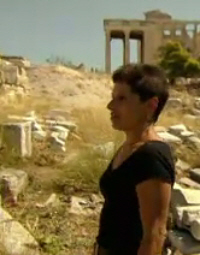Arrephoroi
and the Goddess Athena
Athen, 500BC.
You could argue that what happened here in Greece gave us the building blocks for Western civilisation – a belief in democracy,
a belief in freedom of speech and the fixed and firm notion that the women were very definitely second-class citizens.
Women were often not allowed out during daylight hours. Some had their faces completely veiled, few would be educated and a woman’s most celebrated
virtue was her silence.
One popular saying by the poet Semonides describes, “Her man couldn’t stop his wife barking, even after he’d knocked
her teeth out with a stone.”
Acropolis Buildings
Most histories lionise the glorious achievements of Athens’ men. But by focusing just on the obvious triumphs, conquests
in war and monumental buildings, a truer, richer picture is missed.
Up on the sacred Acropolis rock most tourists head straight for the Parthenon, ignoring an overgrown corner that was once
home to a group of young girls, tasked to serve the Athenian state.

Judy Barringer
I’ve come here with historian Judy Barringer.
Judy “This was the location where the Arrephoroi lived. These are young girls who were between the ages of seven and 11. Who
lived here on the Acropolis, for a period of time – about nine months – and there were 2 to 4 of these girls. And they were from
elite, aristocratic families.”
On the brink of puberty. These are young girls who were between the ages of seven and 11, these young girls were here to enact
a mysterious religious ceremony.
Professor Barringer “They had to leave from the Acropolis with some baskets on their heads and in these baskets were unseen
things, things they were forbidden to look at. And they had to take them down a staircase to a place near, a shrine of Aphrodite
in the gardens. What we heard from ancient sources is that what was in the baskets were clay models of either fruits or snakes,
or phalluses, genitalia, or all three. And so these were really sacred objects, important things”
If you see them walking down here to the shrine of Aphrodite, there must be something sexual going on here as well. Because
they are on the cusp of puberty, aren’t they, if there are aged 11 or 12?
Judy “Girls married very young in antiquity. We think as soon as they had passed puberty, as soon as they were menstruating and
ready to bear children, they would be married.
Many scholars have seen this as moving from the realm of Athena, here on the surface
of the Acropolis, down the staircase to the shrine of Aphrodite, that is moving from virginity to sexual love or preparation for
marriage and motherhood, eventually. And if it’s a rite of passage to marriage, then it’s extremely important in terms of symbolic
fertility.”
These girls were enacting a ritual to safeguard the fertility of the whole society. What was at stake was nothing less than the
survival of the Athenians themselves. Religion gave these young women a vital role. And they weren’t alone. All over Athens, women
served as priestesses. They were physically the keepers of the keys of huge temples, personally wealthy, and their voices, even in
the male-only, democratic assembly, could be heard. Religion made them matter.
In a world which treated women as worthless, priestesses enjoyed high status. Life is quite tough for women, so do you think
this is a kind of one moment where it becomes more bearable and more than that, were they really do have some kind of power and control?
Judy “They certainly do have power and control in religion. If you take women out of Greek religion, it’s basically empty. They’re
really central in virtually every aspect of Greek religion, from rituals to the goddesses themselves.”
